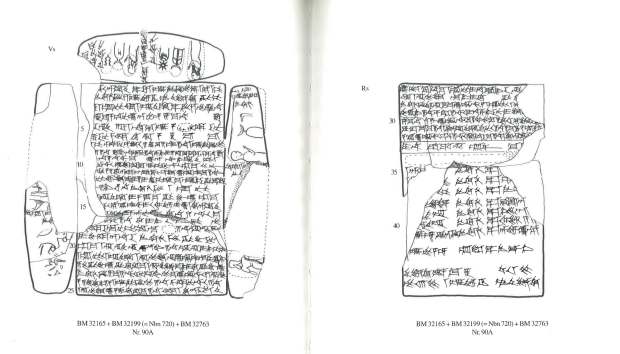Reading Babylonian administrative documents can be a rather boring task, because of the formulaic and factual language in which these texts are written. Yet, once in a while, Assyriologists are lucky enough to catch a glimpse of real life situations in them. A particularly comical story can be found in a text recording court proceedings dated to the reign of Nabonidus (22nd of October 543 BCE).

Wunsch 2000
A person called Itti-Marduk-balatu has appealed to the royal court to help him solve a dubious legal problem. At the beginning of the text, the background story is sketched: two men (Shapik-zeri and Bel-uballit) had previously sold a field to the father of Itti-Marduk-balatu. After his father’s death, they approached Itti-Marduk-balatu with a debt note, that says that the field in question was pledged as mortgage to a certain Rimut. In Babylonia, the possesion of a debt note could mean two things: either the document was in the hands of the creditor, which meant that the debt was outstanding (and in this case the tablet served to sustain this claim), or the debt note was in possesion of the debtors, proving the fact that the debt had been repaid. In this particular case, the latter was true and the debt had therefore been repaid.
Now, the two men proposed to sell the debt note to Itti-Marduk-balatu for 1/10 of the original debt (30 shekels of silver, which was approximately one to two years of income for a regular worker). It is unclear why the latter would have had any advantage in purchasing the document, because it would only have served him in case Rimut (the previous creditor of the field) would come to repeat his claim. The whole business seemed suspicious to Itti-Marduk-balatu, and he requested to see the debt note himself. While he was carefully studying the tablet, he grew even more mistrustful and asked if the two men could bring him this Rimut. Upon this request, one of them snatched the tablet from his hands and started chewing on it – a vain attempt to destroy the thing.
In the end, Itti-Marduk-balatu went to court, where he was confirmed in his suspicions, and the two men were sentenced to pay ten times the amount of the original debt. They were placed under custody, as an incentive for the scribe, who wrote the falsified document, to come forward and admit guilt.
To the judges of Nabonidus, King of Babylon, Itti-Marduk-balatu has spoken as follows: “Shapik-zeri and Bel-uballit have a debt note for 5 mina of silver, owed by them to Rimut, for which their field, situated in the vicinity of the Hazuzu-dig, has been taken as pledge. This field has been sold to Nabû-ahhe-iddin, my father. Now this document was presented to me and they said: ‘Give us 30 shekels and we will give you the document.’ I held the document and said: ‘Who is Rimut, to whom the field is pledged?’ and Shapik-zeri snatched the tablet from my hand and bit it with his teeth. Establish your decision.”
The judges questioned Shapik-zeri and Bel-uballit and they defended themselves as follows: “The debt in the note has been paid and what Itti-Marduk-balatu told you is true, but we did not bring this tablet as a case against him before you, he brought us here!” The judges spoke as follows: “Bring us Rimut, the creditor in this document!” Shapik-zeri and Bel-uballit could not bring Rimut before them. They changed their statement and now claimed: “We do not know this Rimut.”
The judges listened to all the statements: that the debt note of Rimut was written to state that the field which Nabû-ahhe-iddin had bought, served as pledge; that they had brought it to Itti-Marduk-balatu; that Shapik-zeri had chewed on it; that they had said “we do not know this Rimut”.
The judges deliberated. The debt note that Shapik-zeri and Bel-uballit had brought, was made to deceive. The 5 mina of silver, recorded in the debt note, they will pay in tenfold to Itti-Marduk-balatu, and to bring forward the scribe, who wrote the false document, they were placed in fetters and handed over to Itti-Marduk-balatu.
BM 32165+//MNB 1810 (a free translation by CD)
(Many thanks go to Julia Giessler, who so vividly presented this text during her talk at the 65th Rencontre assyriologique internationale in Paris)
Further reading
- Wunsch, Cornelia. Das Egibi-Archiv. Groningen, 2000.